 
 Today is
Today is
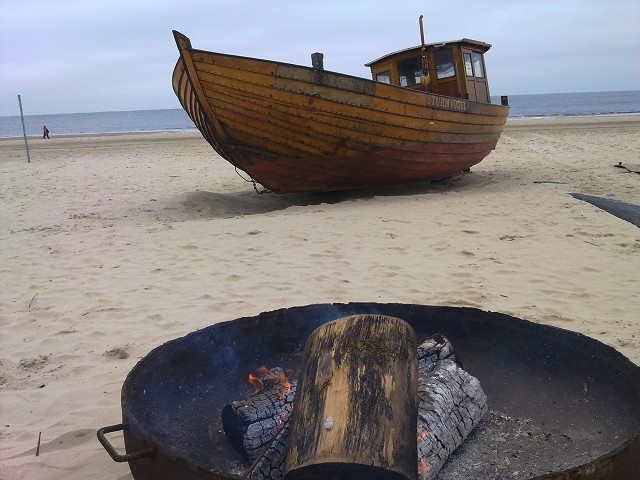
The island of Usedom, also known as
Berlin's Bathtub (Badewanne Berlins) is located
in the Pomerania
Euroregion
where the most famous and beautiful Baltic
seaside resorts were established in the 19th
century. It's also the sunniest part of Germany
and Poland. The island has 44 km (27 miles) of
shoreline with pristine, sandy beaches. It could
be compared in many ways to Martha's
Vineyard, Nantucket or The
Hamptons
in the USA, for example.
Usedom Island is called Wyspa
Uznam in Polish. It is a divided
island
between Poland and Germany on the Baltic
Sea. The
island is named after the town of Usedom (Uznam), which is one of
the oldest, if not the oldest settlements there.
The German and English names of the town are
derived from the former Slavic name Uznam,
which means "a river mouth". The town
and the island of Usedom still are named Uznam
in the Polish language. Hence, you will find both
of those names used on the island, depending on
which side that you are on. And yes, you can
visit both Germany and Poland while you're there.
The island was created as a result of the latest
ice age, the Weichselian
Glaciation,
which reached its climax about 18,000 years ago.
The site of the town of Usedom (Uznam) was
settled since at least Neolithic times. Other locations
mostly on Southern parts of the island were
settled as early as the Stone
Age.
Pomerania was fortunate to keep its unique
indigenous culture longer then many other
European regions. It was Christianized late in history, on June
10, 1128 when the Pomeranian
dukes were
forced by German missionaries to
convert to Roman Catholicism. That historic date
also marks the beginning of the fall of the
dukes, many deaths, witch trials and a leanthy
process of Germanisation of the region. Perhaps
such events inspired The
Amber Witch,
a book written in Koserow (Coserow) on the island of
Usedom in about 17th century. The book was
published by Wilhelm
Meinhold
in 1838; its German title is Maria
Schweidler, die Bernsteinhexe. In later
centuries, the island became a part of the Kingdom
of Prussia
(1525-1918), and after World War I a part of
Germany [History
of Prussia].
During the Thirty
Years' War
the island became largely depopulated. And after
the fall of Prussia, many German Pomeranians
relocated primarily to the metropolitan areas of Berlin and Hamburg. Perhaps that's another
reason why the island had become so popular with
their descendents from those regions. Many other
Pomeranians emigrated to the United States, and
settled mainly in the State of Wisconsin [more
info].
|
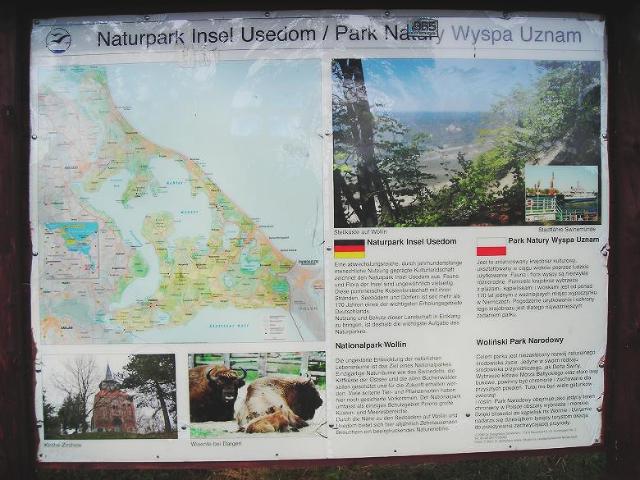
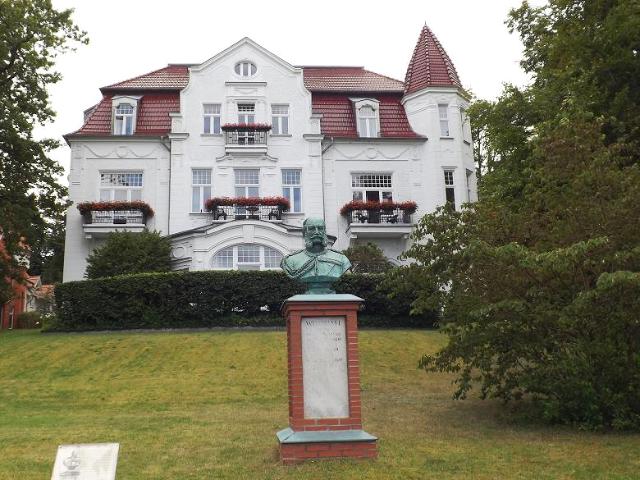 Emperor Wilhelm I often stayed in this seaside villa in Heringsdorf.
His palaces were in Potsdam or Berlin, among other places.
See it @ Google Maps.
Emperor Wilhelm I often stayed in this seaside villa in Heringsdorf.
His palaces were in Potsdam or Berlin, among other places.
See it @ Google Maps.
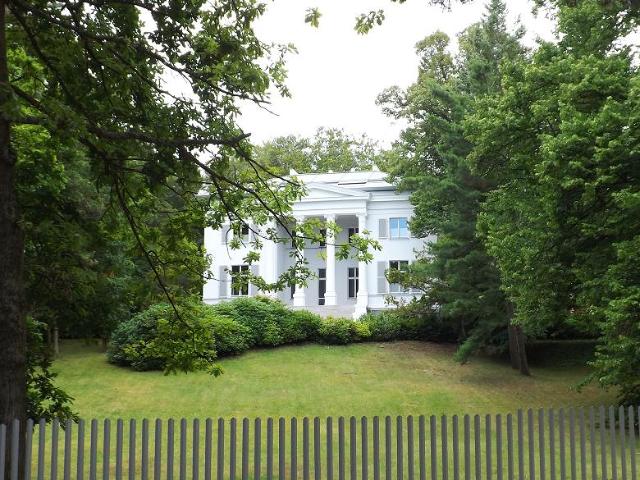 Villa Oppenheim in Heringsdorf.
A fine examples of 19th-century architecture on the island.
L. Feininger often used this villa as a motif for his watercolors and woodcuts.
Villa Oppenheim in Heringsdorf.
A fine examples of 19th-century architecture on the island.
L. Feininger often used this villa as a motif for his watercolors and woodcuts.
Lyonel
Feininger
(1871-1956), a leading New York expressionist painter spent summer
vacations on Usedom Island from 1909 until 1921
when he was studying art in Berlin. He was
greatly inspired by the island and created many
painting and drawings there and continued
painting scenes from the island for the rest of
his life, after returning to the United States. A
fifty kilometers long Lyonel Feininger bike tour
was created on the island with signs on posts and
round markers on the ground to locations that
were immortalized in the artist's works. Some of
those are the Dutch windmill of Benz, the church in Benz, and
the iconic Lightmill (Mulenbake, Stawa Mlyny)
in Swinoujscie.
|
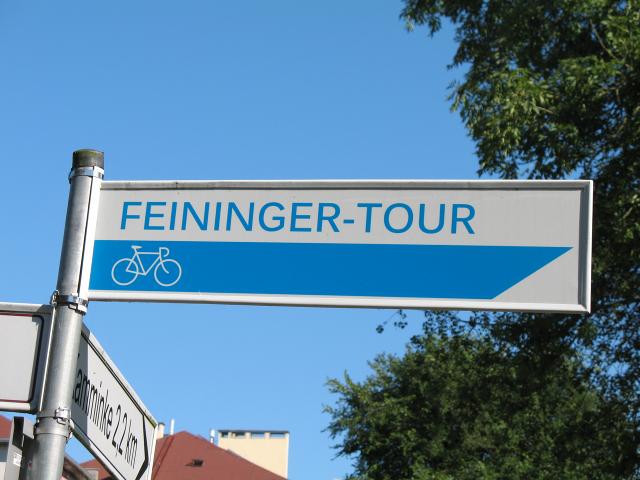
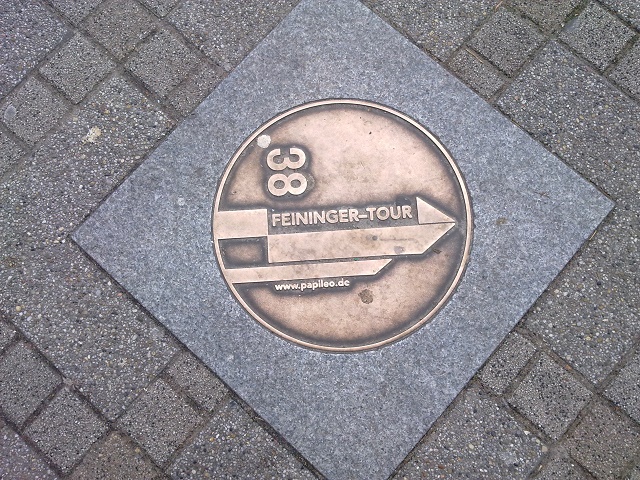
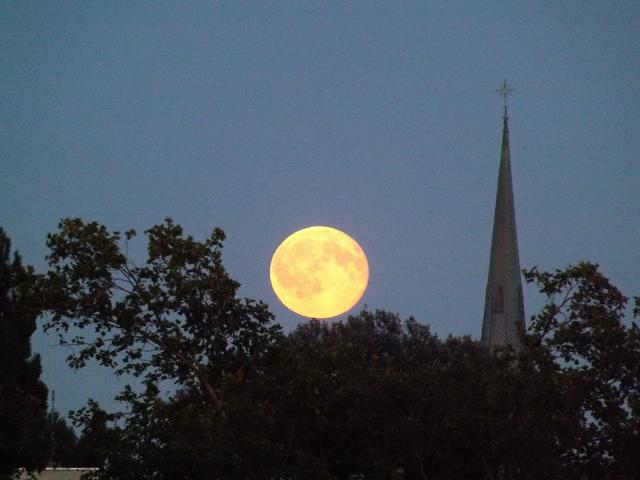
Usedom Island has
been popular not only with artists, bourgeoisie
and aristocrats. It was also a destination for
followers of early counter-culture movements such
as Lebensreform, which was an early
freedom culture movement, for the FKK
movement
and Wandervogels, a youth movement
originally from Berlin. And by the way, the above
mentioned movements later became prototypes for
California's Nature
Boys and
1960s hippies. According to some
sources, the island was also a popular
destination for some East
German
(GDR) dissidents during the Cold War. Your guide,
the author of this article also used to be a flower
child and
a participant of the 1960-70s Peace
Movement
in the United States.
Since Poland signed the Schengen Agreement in
2009, the long promenades of Poland and Germany
joined to form a "Grand Strand" that's
over 40 km long. It's now Europe's longest
promenade or esplanade. There is also a bicycle
route along that Grand Strand, which passes
through the island's four spa resorts of
Swinoujscie, Ahlbeck, Heringsdorf and Bansin.
There is also a sidewalk along that same route
that is ideal for tracking, walking or Nordic
walking. The route connects with other bicycle
routs that lead to Zinnowitz, Wolgast and neighboring islands of
Rugen and Wolin . |
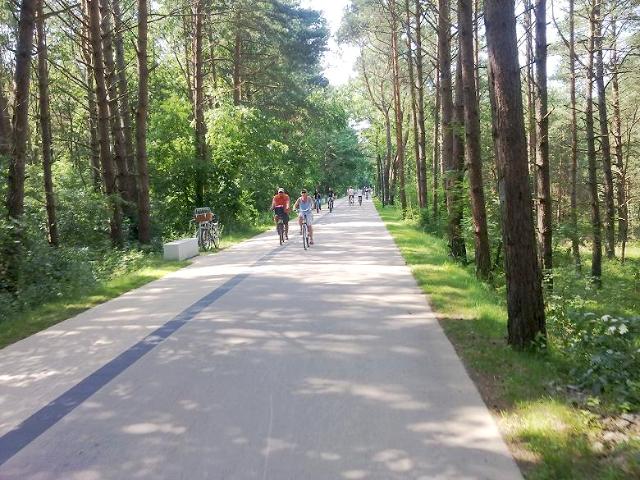
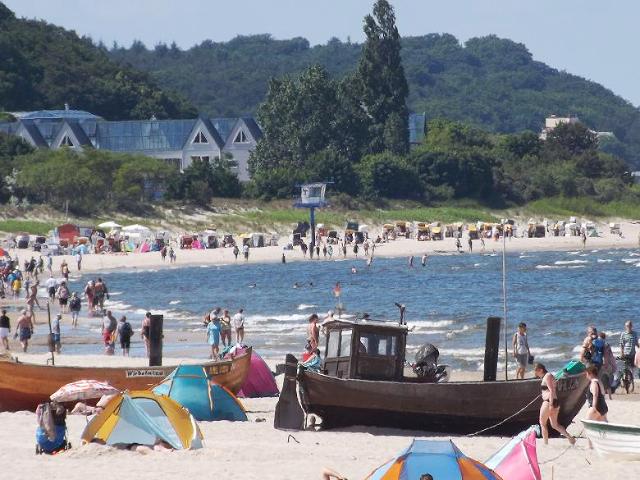
Every town and
village on the island has a unique character and
community sense of its own. The oldest and most
popular resorts are Swinoujscie, Zinnowitz, and the three Kaiserbader
i.e. Ahlbeck, Heringsdorf, Bansin.
Usedom Island is near the cities of Berlin, Hamburg, Rostock and Szczecin
(Stettin).
It's easy to reach through various forms of
transport. There are dedicated bus services and a
train company Usedomer
Baderbahn
(UBB) with headquarters in Heringsdorf that connects the island
with Greifswald, Stralsund and Berlin. There's also Heringsdorf
& Swinoujscie Airport that connects the island
with some cities in Germany and Switzerland.
There's also the Peenemunde
Airfield
for zepplins and private aircrafts.
Naturists may also find a seasonal naked
airline
service from one of the German cities. For those
who would like to travel on their own two wheels,
there is a regional long-distance bicycle route
(BER-04) between Berlin and Usedom that's approx.
337 km / 209 mi long. Bicycles are more then
welcome everywhere on the island. Don't have a
bike of your own? No problem. There are many
reasonably priced bike rental services available.
But remember not to leave your bike unattended. |
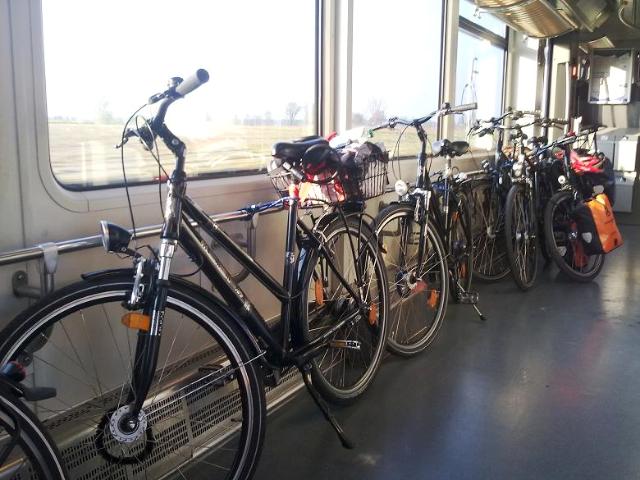
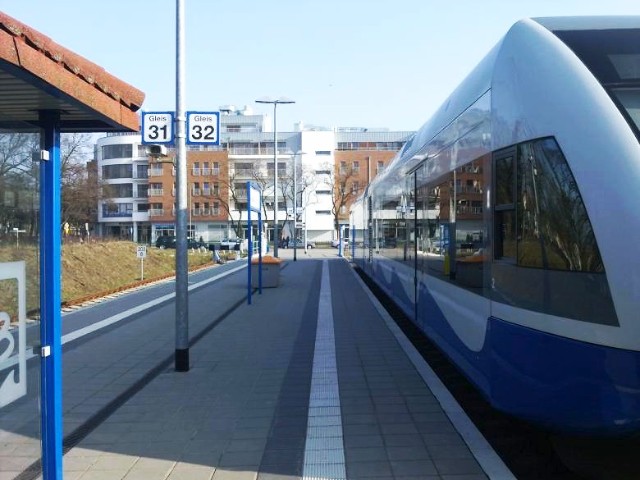 UBB train at Swinoujscie station. Notice the blue sea wave design on the bottom of the train.
See it @ Google Maps
UBB train at Swinoujscie station. Notice the blue sea wave design on the bottom of the train.
See it @ Google Maps
Usedom Island is
perfect for enjoying simple pleasures such as
camping, biking, kitesurfing, hiking, fishing,
tracking, walking, Nordic
walking,
Yoga, chilling, etc. There are camping sites,
beaches, parks, forests, animal and botanic
farms, museums, golf courts, skateboarding parks,
marinas, promenades, boardwalks, many piers,
cafes, shops, restaurants, lots of fresh air and
clean water for everyone to enjoy. And if that
gets a bit dull, the island has modern shopping
centers and other facilities for your
convenience.
Most of the island is a nature reserve with rare
wildlife such as bison (buffalo) at a ranch near Dargen, rare bird species such as
the giant sea
eagle and
wild animals that may often go roaming about
freely.
For those who are artistically inclined or
interested in Yoga and alternative science, the
island has positive energy and the right climate
for inspiration, meditation, opening of energy
centers, rejuvenation and healing; especialy at
the many spas; some also offer brine and mud
baths from local natural wells.
On the spiritual side of life, there are old
churches and an ancient pilgrimage route to Camino
de Santiago
known as the Way of
St. James.
The Pomeranian Way of St. James is marked with
sea shell design trail markers (see photo below). More info here and here. |
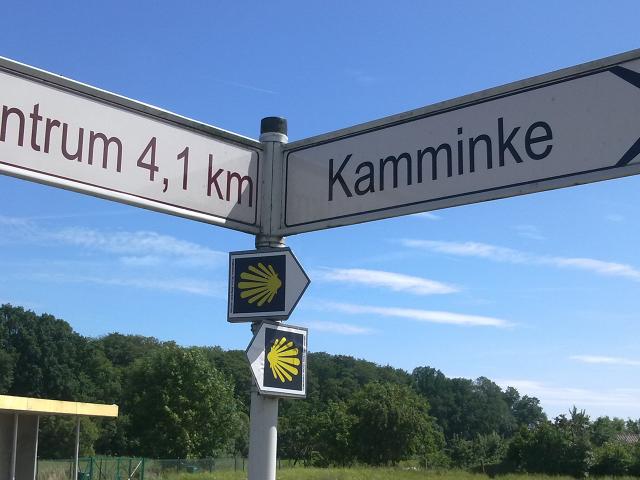 Sea shell design trail markers on the Pomeranian Way of St. James
Sea shell design trail markers on the Pomeranian Way of St. James
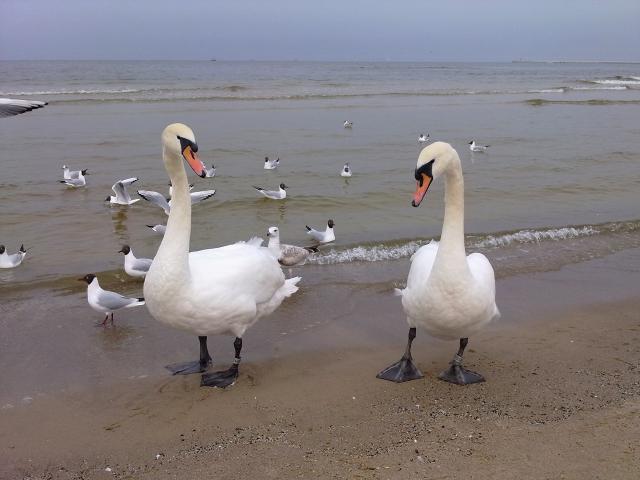
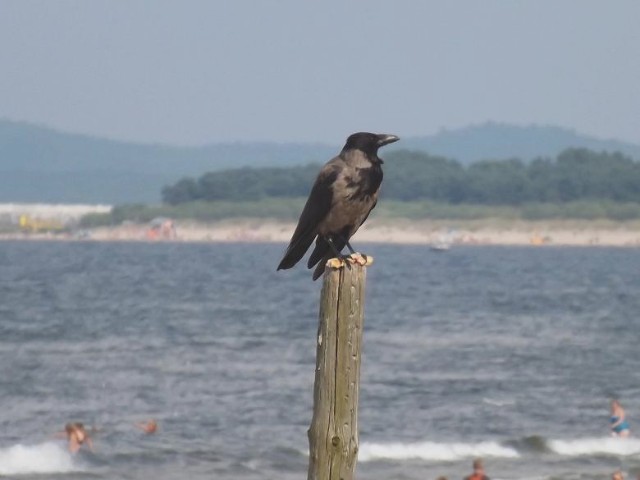
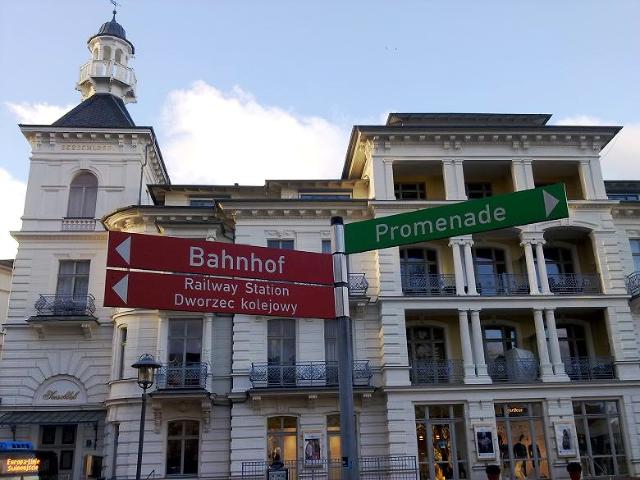 Towns are clean, streets are clearly marked and utility lines including electric cables are underground
Towns are clean, streets are clearly marked and utility lines including electric cables are underground
Usedom Island is
a destination for travelers on every size budget
seeking a laid-back getaway in an Ecozone on the Baltic Sea
(Ostsee). It's never been easier to reach the
island, and more connections are in the making.
The islands of Usedom, Rugen and Wolin have a long Viking, German
and Slavic history. There's even a German-Slavic
Viking festival held every year at the Viking
village of Jomsborg and Vineta on neighboring Wolin
Island. There's lots of things to do, sites to
see and reasons to make your visit a pleasent
one. But if for some odd reason things don't go
as planned, no matter what you do or where you
may travel, keep in mind this saying by an
anonymous sailer;
As we sail thru life, don't avoid rough waters,
just sail on because calm waters won't make a
good sailor.
Word of advice
for a pleasant stay
Almost everywhere in the world
tourists might attract pickpockets, bicycle and
car thieves, and my get overcharged by some taxi
drivers and waiters. On Usedom Island one should
also be aware that on the German side of the
island are fresh air tax collectors, and
that they are for real. Yes, you read that
correctly. On the German side of the island
visitors are expected to pay a fresh air tax on
arrival. It's just a few Euros if you get stopped
by a collector. But the experience of getting
stopped in a public place may be a shocking one
for some tourists. So, don't forget to carry some
change with you when going to the beach or on a
walk. There's a similar tax on the Polish side
called a climate tax. But visitors to Swinoujscie
have to pay that tax 24 hours after arrival. Most
often that's done automatically in places of
accommodation. Therefore, we advise visitors not
to leave baggage, bicycles and other belongings
unattended, to check prices, and to carry at
least a few Euros for the German tax collector.
|
Usedom
Island is well connected with the world. Internet
services are available in many establishments.
Free Wi-Fi hotspots can be found around the
promenade on the Polish side of the island. |
|